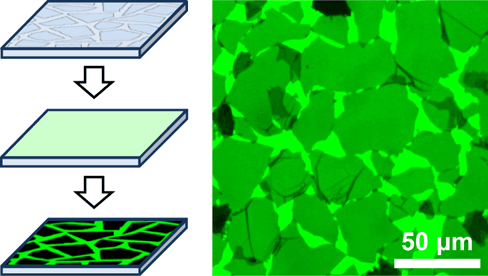Fluorescence quenching microscopy
We have invented FQM, a technique allowing rapid visualization of 2D sheets on arbitrary substrate using a common fluorescent microscope.
Graphene-based sheets are world’s thinnest materials: They are single atomic layers with lateral dimension extends well into tens of microns. The first characterization step is typically microscopy imaging to determine whether single layers are present, their positions on the substrate and sizes. It is an indispensable quality control tool for manufacturing graphene-based materials since it can provide immediate feedback to improve synthetic and processing strategies. Imaging is also crucial for evaluating the microstructures of graphene thin films such as surface coverage, degree of wrinkles, overlaps, and folds of individual sheets, which affect the overall material properties. Conventional imaging tools including electron microscopy or scanning probe microscopy techniques have limited capacity for seeing graphene, and they typically rely on the use of special substrates. We have developed a new tool called fluorescence quenching microscopy (FQM) for seeing the family of graphene-based sheets and some other 2D materials. It allows high contrast, high throughput visualization on arbitrary substrates and even in solution.

FQM image of GO sheets on glass slide
FQM offers high-contrast and high-throughput imaging capability on arbitrary substrates, especially glass and plastics, using existing fluorescence microscopes. The layer contrast mechanism is based on the ultra-long range energy transfer between graphene-based sheets and fluorescent molecules. This allows thicker features such as wrinkles, overlaps or multilayers to quench fluorescence more strongly than single layers, making them readily visible in the images. Therefore, FQM can produce images that are often indistinguishable from those taken by scanning electron microscopy (SEM).
Also see:
- Nature Chemistry – Research Highlights: Microscopy: Glowing graphene
- C&E News: Gilded graphene